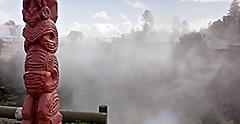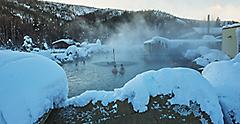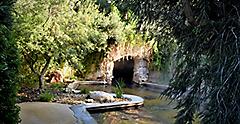But as I became more interested in immersing myself in the unknown, I learned there's more to life than packed itineraries and frequent flier miles. As the writer Ann Lammot once said: "Almost everything will work again if you unplug it for a few minutes ... including you."
Uplugging sounded nice, so I decided to give the healing waters of hot springs a try. My first experience was a little nerve-wracking, but within five minutes, the warm spring waters melted away my worries and left me feeling more relaxed than I'd been in years. The next day — and I'm not exaggerating — I felt and looked rejuvenated.
Overnight, this adventure traveler was suddenly hooked on relaxing in hot springs.
Exploring Famous Hot Springs And Vapor Caves
Hot springs and vapor caves are natural phenomena that run on nothing other than good old volcanic power. Deep underground, water is heated up by molten magma and pressurized until it bubbles to the surface, infusing the water with a unique mix of minerals from nearby rocks along the way.
Hot springs are found worldwide, from Peru to Japan to New Zealand and even Africa. They're hot water pools that can be as small as a bathtub or as big as a football field. In most cases, the pools themselves are man-made (or at least man-maintained), and fresh geothermal water is pumped in around the clock.

On the other hand, there's only one place in the world where you can experience a vapor cave. The steamy Yampah Caves in Colorado are deep inland, a three-hour drive from Denver. The Northern Ute Tribe has long used the Yampah hot springs and vapor caves for the water's healing powers. The owners of Yampah hot springs (the area was westernized in the late 1800s) still invite the Northern Ute people to conduct traditional ceremonies within the caves, preserving their historic rituals.
Your experience visiting hot springs depends on where you go. As is true of any public bathing space: Etiquette is everything. Research the appropriate attire in advance (some may allow nudity), avoid bringing glass bottles, and respect the local culture. In my personal experience, there's nothing more effective at bringing people together than gingerly melting into a hot spring bath. I've even joined in on local conversations and discovered some mind-blowing foodie spots in the process.
A little note on weather: Ignore it. It doesn't matter how hot or cold it is outside. Whether it's sunny or snowing, each change in weather ushers in dramatic new landscapes and sensations to enjoy.
Quick Tips For Visiting Any Hot Spring In The World:
Be prepared to get naked in some spots. In other bathhouses, the pools can be mixed gender, making swimsuits compulsory.
Don't drink alcohol before or during your time in a hot spring. It doesn't interact well with the heat and can cause you to feel lightheaded or faint. It is, however, quite satisfying to have a cold drink afterward.
Try a cold shower or ice bath directly after. This switch in temperatures is said to be excellent for your skin and immune system.
The Mystical Experience Of Natural Water

Why are hot springs such revered places? Is it the water's high mineral content and subsequent healing properties? The mind-blowing scenery that often accompanies their location? Or maybe it's simply the awe-inspiring event of hot water bubbling up from the ground. Whatever it might be, hot springs still hold profound spiritual significance worldwide.
In New Zealand, the passionate, strong, and inspiring Māori people (native to New Zealand) have passed down the origin story of the Hanmer hot springs for centuries. These springs were discovered by voyaging warrior Māori when their canoe was wrecked off the Otago coast. To save the party from freezing in the cold, the warrior Tamatea prayed for the "Ariki" chiefs of nearby volcanoes to save them. In response, the Ariki sent a ball of flames down the Wanganui River. A piece of those flames is said to have landed in Hanmer Springs, saving the warriors from freezing and giving rise to the hot springs you can still visit today. The area is known to the Māori as "Te Whakatakaka O Te Ngarehu O Ahi Tamatea — where the ashes of Tamatea's fire lay."
Across the Pacific Ocean, the native Khoi people of South Africa have long known about the healing properties of the Caledon hot springs. Caledon is one of the rare hot springs not heated by a nearby volcano. Instead, an underground river travels at tremendous pressure through heated rocks more than a mile down. The waters are rich in minerals like iron, manganese, and silica and are surprisingly free of organic matter. Samples of Caledon's springs won the 1893 Chicago World Fair's prize for one of the world's top-quality mineral waters.

Experiencing The Onsens In Japan

How can you talk about the best hot springs and not go on and on (and on) about Japan? You can't.
From soaking in a snow-surrounded hot spring in the mountains of Matsumoto (where premium Wasabi is grown) to melting off the stress of big city life in Osaka's Spa World onsen theme park, it's a wandering traveler's dream. And don't even get me started on the hot springs of Kutasu — the entire town is one gigantic onsen heaven, complete with the best quality waters in the whole country. If you're timid like me and worried about the no swimsuits rule, don't worry, you can find alternative options. One of my most enjoyable experiences was in the onsen of Enoshima Island — just outside Tokyo — where I got to wear my bikini, sink into the warm waters, and watch the sun go down behind the majestic bulk of Mount Fuji. There are no words to describe that kind of inner peace.
Every open-air hot spring in Japan is a picturesque marvel worth a visit. And if you can't find time, most of the traditional "ryokan" hotels will have their own baths for you to enjoy free of charge.

Finding Secret Hot Springs In Unlikely Places In The World


Soak In The Best European And Australian Hot Springs

Iceland is well known for its dramatic volcanoes, lava fields, and glaciers. Hot springs and geysers are dotted throughout the island thanks to the lively geothermal activity underground. The most impressive pool is the Blue Lagoon, one of the most famous hot springs in the world. The bright aqua lagoon looks like a medieval movie set. Its brackish water carries high loads of silica, which reflects and diffuses the sunlight giving the pools an almost eerie ice-blue tint. The silica (a mix of silicon and oxygen) settles on the pool floor, creating a thick white mud, which makes an excellent facial treatment. Many bathers scoop up this mud and use it as a mud mask. But there's even more to this special pool — the unique combination of minerals and salt has given life to a special type of algae that only grows at this location. The algae and mud have been used to create excellent skincare products you can take home.
On the northern edge of Norway lies the Stave hot springs. The pools themselves are refreshingly simple and overlook the Arctic Ocean. It's a humble setting for the miraculous vista. You can expect northern lights and even a midnight sun — the sun doesn't set in Norway's summer, giving you endless days. It's worth heading down to the Stave Beach Sauna, where you can get all toasty warm before plunging yourself into the freezing Arctic Ocean.

The Most Private Hot Spring Destination In The Worlds
If you've read this far, then you're probably wondering where's the hot spring on that elusive seventh continent, Antarctica? Mother Nature's not one to disappoint; there is a hot spring in Antarctica. It's on Deception Island — an old, abandoned whaling station. Deception Island has a number of varying microclimates, so beyond the freezing Antarctic winds and near the volcanic areas, the air and water get very hot. If you're in the area, bring a swimsuit and a travel shovel to dig a shallow private hot spring pool in the black volcanic sand, which releases boiling hot water.
I've covered the more popular hot springs on each continent, but there are hundreds of unique locations still to be found. While you meander the streets of countries like China and Morocco, keep an eye out for natural springs. You may just be surprised by what you find.

